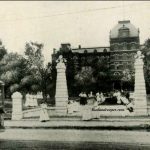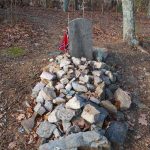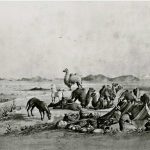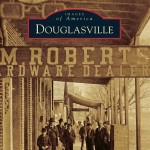
Listen my children and you shall hear of the midnight ride of John Wisdom on the third of May, in sixty-three….
Something isn’t quite right, is it?
Back when I was in the classroom I would introduce “The Midnight Ride of Paul Revere” by Henry Wadsworth Longfellow, to my fourth graders when we discussed Lexington and Concord, and the visual I provided is the painting seen here by Grant Wood.
Near the end of the year as we discussed the Civil War I spiraled back to Longfellow’s poem to remind students where we had already been in our studies. I would write the opening words of the poem on the board except I switch the name Paul Revere with the name John Wisdom and the date.
As students began to correct me I would say, “Oh yeah, sure, it was John Wisdom. He warned people the enemy was approaching. He may have saved people and the towns of Lexington and Concord on his midnight ride.”
I loved the chorus of “no, no, no” I received from adamant students who loved to point out when I was wrong. They would tell me that Paul Revere and several others were charged with the duty of calling out the Minutemen, and the date was 1775 not 1863.
Our spiral review is successful and completed. Students remembered information concerning the Revolution though it has been several weeks since it was taught.
I would turn to present matters and pose the question, ”Well, I wonder then why the name John Wisdom popped into my head? Who could he be? I wonder if he did something important. We are about to study the Civil War. Based on what you know already about the war write two or three sentences in your notebook predicting who you think John Wisdom might be and why I’m bringing him up.”
Students would begin to scribble in their notebooks and then share their predictions. Finally, I would get my chance to share.

John Wisdom, seen here to the left, was a real person. He was a mail carrier. You know the type…through the dark night, through rain, sleet, snow, hail…yeah, THAT mail system.
It can be argued that he is the very man who saved Rome, Georgia from destruction during the Civil War at least for a short period of time. He is often thought of as Georgia’s version of Paul Revere.
In May, 1863, Rome was only about sixty miles south of the Confederate lines at Dalton, Georgia. There were only old men, wounded soldiers, and young boys available to protect the town and the arsenal. I guess you could say the leaders of the South were asleep at the wheel as far as Rome goes.
Why would Rome have been important to the Union?
First of all, the city is located strategically at the point where the Etowah and Oostanaula Rivers meet forming the Coosa. Railroad lines that connected Atlanta and Chattanooga ran through Rome. Many of the farms in the region provided food supplies for the Confederates, and the hospital provided medical supplies and care for the wounded. The city had numerous foundries including the one owned by James Noble, Sr. and his six sons. Their foundry had been instrumental in providing the Rome Railroad with a locomotive by 1857. Cannons and cannonballs as well as other items to assist the Confederacy were manufactured in Rome.
Rumors abounded in the countryside the Union Colonel, A.D. Streight, was on the move. Was he heading for Rome’s arsenal? Was he attempting to cut the Confederate supply line between Atlanta and Chattanooga? Actually it was the latter, but Wisdom felt a burning need to let the countryside know the Union troops were nearby and up to no good. Haven’t you ever heard a rumor and couldn’t stand it until you told others?
Wisdom, apparently was unaware that General Nathan Bedford Forrest was already in pursuit of Streight and it was a good thing he didn’t know or didn’t care. Had someone have said, “Awww….Forrest is already after him,” Wisdom might have just gone about his duties as a stage driver delivering mail and other parcels. Nope, Wisdom opted to get involved.
Forrest was able to capture Streight’s cavalry after three to five full days (depends on the source you use) of marching and fighting. The Confederate officer managed to do this with a force less than half the size of Streight’s. Forest had several advantages over Streight, however. The Confederates were riding horses while the Union soldiers were using mules. In fact some sources refer to Streight’s group and others that utilized mules as “Jackass Forces”. It was hard for these forces to get around unnoticed as the mules often took to braying and could be heard for miles. At some point during the chase Streight dispatched approximately 200 men to serve as an advance party to head for Rome to scout the area. It was this scouting party that Wisdom heard about and set out to warn his surrounding neighbors.
It is at this point I will defer to the website Rome.Georgia.com as it explains the arduous journey of Wisdom better than I can:
“He left Gadsden at 3:30 in the afternoon by buggy and after 22 miles at Gnatville his horse was completely exhausted. A widow Hanks at that place owned the only horse- a lame pony- which she loaned to Wisdom. The pony only lasted five miles until he came to Goshen. Here he was able to get a fresh and stronger horse which carried him to Spring Garden where he was able to get two horses. At a point about one mile south of Cave Spring, Georgia, his mount was exhausted and darkness had come.
Farmers were reluctant to loan their animals nevertheless he walked on and even used a mule for several miles until he was able to get two good mounts in Vann’s Valley in succession and raced into Rome after midnight.”
Rome’s citizens were quick to act once they were alerted:
“The covered wooden bridge over which the Union troops would be forced to move was barricaded with bales of cotton and the bridge floor covered waist deep with hay soaked in oil which was to be set afire in the event the invaders could not be stopped by other measures.
The engineers of the Rome Railroad made trips into the countryside warning the people and bringing the planters who responded to the call to arms. They brought their squirrel rifles, muskets, and muzzle loading shotguns.”
The Union advance troop got a good look at Rome from the hill at Shorter College where they could see the fortifications the town had hastily put together. They knew even with their small number they could have taken the city with the element of surprise, but since the citizens had prior warning and had prepared it was fruitless. They returned to rejoin Streight’s command and eventually wound up as prisoners of war with their comrades.
Wisdom received $400 and a silver service for his basically unknown ride. General Forrest is honored with a statue at the corner of Broad and Myrtle Streets where Myrtle Hill Cemetery is located. One of the inscriptions state: “On Sunday, May 3, 1863, General Nathan B. Forrest by, his indomitable will, after a running fight of three days and nights, with 410 men, captured Col. A.D. Streight’s Raiders, numbering 1600, thereby saving Rome from destruction.”
Students always end the discussion asking about the fate of Streight. He ended up at Libby Prison outside of Richmond, Virginia. He escaped with 108 other prisoners right under the noses of Southern guards through a tunnel on February 9, 1864.
Following the thwarted raid earthen fortifications were built to serve as some protection for Rome, however the city was eventually taken and held by Union forces. Union Gen. Jefferson C. Davis took Rome without specific orders in May, 1864 during his search for a bridge that didn’t exist across the Oostenaula River around the time of the Battle of Resaca. Gen. Davis communicated to Sherman that, “[Rome was] the strongest fortified place I have seen in Dixie.” More Union forces were sent to the city after General John Bell Hood began to strike at Sherman’s supply lines in North Georgia. It was from Rome that Sherman telegraphed Grant concerning his plan to “March to the Sea”. Once it was approved he set out from Rome around November 10th and 11th heading South. On their way out of the city many of the downtown buildings and Noble’s Foundry was destroyed by fire.




Leave a Reply